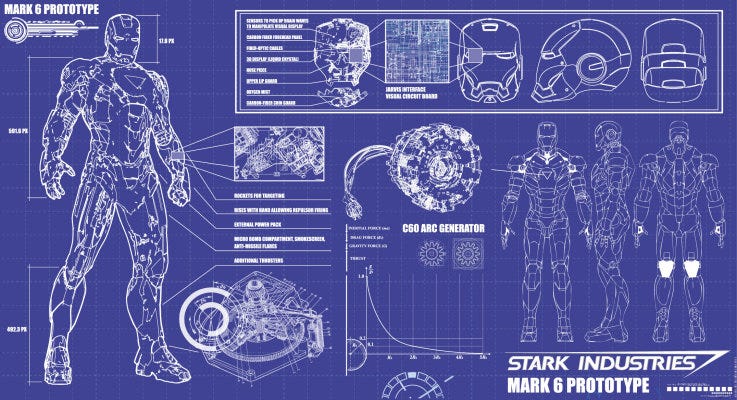
This summer, Dr. Shankar Ramakrishnan challenged the students in his Engineering 202 “Use-Inspired Design” class at Arizona State University to work in teams to design and prototype superhero suits that would effectively meet a set of specific user needs, benefit society, and combine engineering aptitude with creative thinking.
The Center for Science and the Imagination served as judges for the project, selecting the superhero suit design that best met the criteria of feasibility, clarity and usability, social good, and imaginative design. The Rio Solutions team — Mario Borges, Clint Ewell, Austin McCoy, and Daniel McDonald — created the suit that inspired us most. Their design started by reimagining the superhero as someone who provides aid to those who need it most, and not necessarily by engaging in fisticuffs with nefarious criminals. Their suit, designed with input from real-world Emergency Medical Technicians, aims to improve the speed and efficacy of first responders, turning them from everyday lifesaving heroes into superheroes.
Check out the team’s final video presentation, where they unveil their prototype suit:
They also drafted a user manual, instructing prospective superheroes on the finer points of using their design:
Rio Solutions User Manual | Technology
We wanted to learn more about the out-of-the-box thinking and teamwork behind Rio Solutions’ design, so we corralled them for a brief interview about their process:
CSI: What problem or problems does your superhero suit solve? What needs does it meet?
Rio Solutions: Much like superheroes, first responders assist those in need. To do so, they require a large amount of cumbersome equipment to provide medical aid. However, they can’t always rely on ambulances to transport their equipment, especially in the aftermath of natural disasters or in remote locations. Our suit transforms regular heroes like paramedics and EMTs into superheroes by allowing them to carry basic medical equipment on their person.
CSI: How did you conduct research into the problem to design your solution?
Rio Solutions: After narrowing the scope of our project to emergency medicine, we interviewed several EMTs (Emergency Medical Technicians) to assess their needs. Through these interviews, we created a list of medical devices they use frequently, as well as a basic understanding of what each of those devices does. The interviews also helped us identify constraints for our design. For example, our solution would have to be lightweight and compact so it wouldn’t impede the motion of the user.
CSI: How did your team collaborate on the design? How did you share ideas, then divide up roles and responsibilities?
Rio Solutions: Our team began by conducting a brainstorming session to generate and exchange ideas. We then evaluated and debated the merits of those ideas until we reached a unanimous decision. Our next step was to divide the project into small, manageable tasks, which we assigned based on each team member’s strengths and skills.
CSI: How did you structure your design process to be sure that you were creating something innovative and new?
Rio Solutions: Although the prompt for this project was general, our team identified a specific societal need before beginning our design process. This approach ensured we would develop a solution rather than a product. Furthermore, we utilized design tools such as functional analysis to generate innovative ways of performing essential tasks. These methods helped us to develop an innovative, user-centric design.
CSI: What was the most significant challenge you encountered during the process of creating the suit, and how did you go about meeting that challenge?
Rio Solutions: Brainstorming pragmatic ideas for a superhero suit at the beginning of the project was the most significant challenge we faced. At first, we struggled to generate ideas that would actually benefit society, due to our cultural biases. Namely, in an age of blockbuster superhero movies, we tend to think of heroes as crime fighters defined by their superior martial abilities. But the ultimate goal of a hero is to help people in need. Once we realized that, we were able to come up with an idea that would plausibly help people in the real world.
